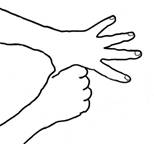Holding the fingers is a Jin Shin Jyutsu self-help practice that is extremely simple and yet profound. Because so many of the Jin Shin Jyutsu energy pathways run through the fingers (the ten fingers are said to regulate 14,400 functions within the body), holding the fingers is a way to balance and harmonize energy in the whole body. I encourage you to give this practice a try.
Attitudes associated with each finger
There is a primary emotion (what Jin Shin Jyutsu calls “attitudes”) associated with each finger. As you can see under the additional benefits I’ve listed below, there are also other attitudes associated with each finger, as well as physical symptoms. You can target these attitude and symptoms by holding specific fingers.
First, let me list the primary attitudes and the benefits of holding each finger. Then I’ll talk about various ways you can practice holding the fingers.
Additional benefits: for depression, hate, obsession, anxiety, self-protection, to revitalize physical fatigue, for the back of the head, breathing, and digestive discomforts. Mary Burmeister recommended holding the thumb at the first sign of a headache.
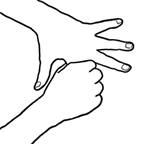 Fear: The index finger.
Fear: The index finger.
Additional benefits: for timidity, mental confusion, depression, perfectionism, criticism, frustration, digestive issues, elimination, wrist/elbow/upper arm discomforts. Mary Burmeister recommended holding the index finger at the first sign of a backache.
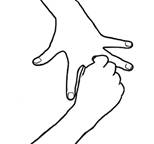 Anger: The middle finger.
Anger: The middle finger.
Additional benefits: for feeling cowardly, irritable, indecisive, unstable, not alert, overly emotional, general fatigue, eye issues, forehead discomforts.
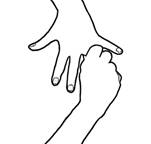 Sadness/Grief: The ring finger.
Sadness/Grief: The ring finger.
Additional benefits: for negative feelings, common sense, excess mucus, breathing, ear discomforts.
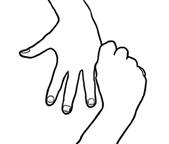 Trying To/Pretense (cover-up): The little finger.
Trying To/Pretense (cover-up): The little finger.
Additional benefits: for “crying on the inside and laughing on the outside” (that’s what’s meant by “trying to/pretense”), feeling insecure, nervous, confused, issues of “why am I here,” calms nerves, aids bloating. Mary Burmeister recommended holding the little finger at the first sign of a sore throat.
There is an acronym to help you remember the primary attitude associated with each finger. It’s “Get rid of Worry FAST.” W is for Worry (thumb), F for Fear (index), A for Anger (middle), S for Sadness (ring), and T for Trying To (little).
How to practice holding the fingers
There are two basic ways to practice holding the fingers. You can either hold all ten fingers, first on one hand then the other, or you can concentrate on the attitudes and benefits associated with just one finger.
When concentrating on just one finger, there are again two basic ways to do this. In Jin Shin Jyutsu, holding just one finger is called a “quickie.” The “quickie” hold simply involves holding a finger on one hand with the fingers and thumb of the other hand. For example, to hold the left thumb, you wrap all four fingers of your right hand around your left thumb.
You might choose to hold your thumb, for example, when you notice that you’re worried. I’ve been holding my ring finger lately because I have some tinnitus in my right ear. Don’t worry about whether you hold fingers on your left or right hand. The energy pathways cross over from one side of the body to the other. It’s more important to do what’s most convenient for you in the moment.
The second way to focus on the attitudes and benefits of an individual finger is to use a longer (extended) sequence for that finger. An extended sequence is a combination of fingers that you hold one after the other. For example, the extended sequence for Worry is to hold the thumb, then hold the middle finger, then the little finger. I’ll describe the extended sequences in the next post.
How long should you hold a finger?
You have several options when it comes to the length of time to hold the fingers. If you have plenty of time, hold all ten fingers, holding each finger until you feel a pulse arrive in that finger. If you find the finger is already pulsing strongly when you first touch it, hold that finger until the pulse calms down.
Another way to hold all ten fingers is simply to hold each finger for two or more breaths. This is a great practice to do throughout the day. It can be very meditative and relaxing.
When you hold just one finger (the “quickie”) to support a particular attitude, you can continue holding for as long as you like. For example, if you’re in a meeting at work, sitting around a table, and something is making you angry (and you don’t want to express that anger at the moment), you can keep your hands under the table and hold the middle finger until you feel the emotion softening.
Holding the fingers as you fall asleep
Holding the fingers before falling asleep is an excellent practice. It not only establishes a habit — a time of day when you’ll do acupressure self-help — but it will help you fall asleep.
In the next two posts I’ll describe first the extended sequence of holding individual fingers and then the finger mudras. Once you know all three practices, you can combine them into a nighly falling asleep ritual. Chances are you’ll fall asleep before you finish.
You can also use this practice if you wake up during the night or if you suffer from insomnia. Focus your mind on the finger and your breath. Notice the difference in temperature between the air that enters the nostrils and the warmer air that you exhale. This will keep your thoughts from racing and keeping you awake.
The different ways of holding the fingers — holding all ten or holding a quickie, holding for two breaths or waiting for a pulse — influence the body on a variety of levels, but they are all effective. Choose a style that feels most comfortable and satisfying to you in the moment.
Related post & pages:
What Is Jin Shin Jyutsu
Jin Shin Jyutsu Resources
Acupressure poitns for memory, muscle cramps, insomnia, and more
Wellness Topics: Insomnia
Creating Your Own Acupressure Self-Help Practice

